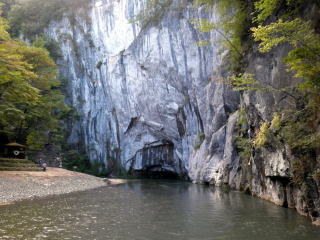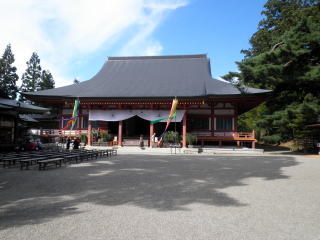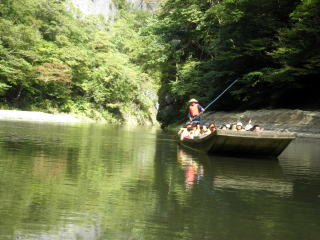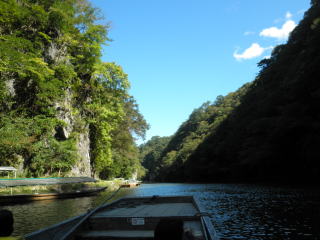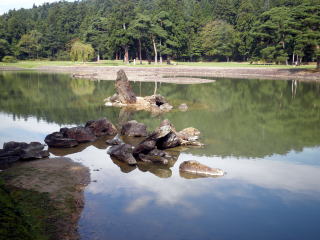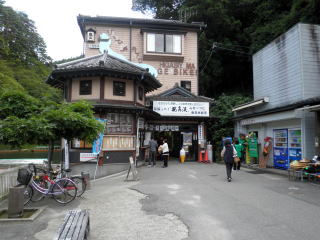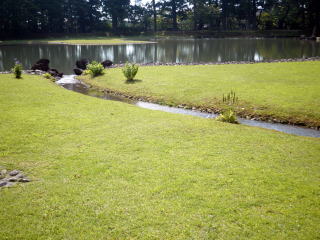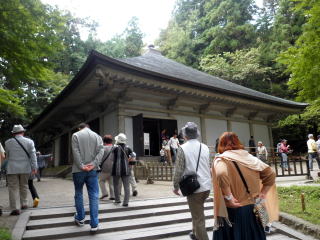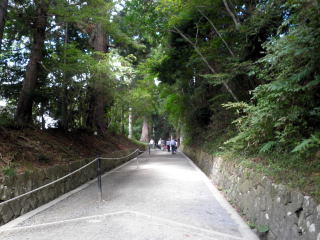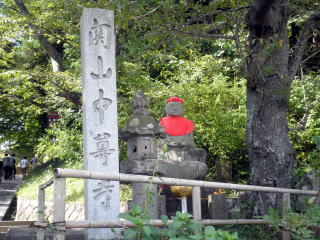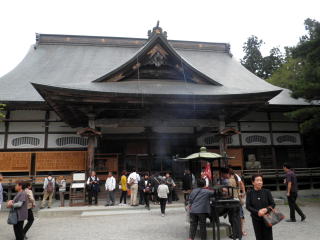2 Motsuji Buddhist temple
HIRAIZUMI, WORLD HERITAGE
3 Boat riding along scenic GEIBIKEI valley
Geibi valley is located about 20 km east of Ichinoseki city.
One goes there after 28 minute ride on a local train of Ohfunato Railway
line from
Ichinoseki and then 5 minute walk, or 40 minute ride on bus from Ichinoseki
station.
Satesugawa (iron sand) river, one of branches of Kitakami river runs along
Geibi valley.
Tourists can enjoy seeing high valley walls of scenic beauty at both sides,
clear water
and many fishes from on a pleasure boat, which a boatman control with a
pole.
The boat ride lasts an hour and half including a walk of 30 minutes at
the upriver.
Rocks in the pond of Oizumiga Ike
This is the Motsuji Buddhist temple.
ENJIN, buddhist priest constructed Motsuji temple in 850, which was burnt
down afterwards.
Then, FUJIWARA Motohira restored the temple in 1117 and constructed other
temples and a big
pond, Oizumi-ga-Ike in its compound.
Do you know why it is called Motsuiji (Passing-over-fur) temple?
An old tale says that when ENJIN monk came here for the first time, he
found white furs on the soil,
passed over them and finally encountered a white deer.
Then he decided to build a temple at this place and named it Motsuji temple.
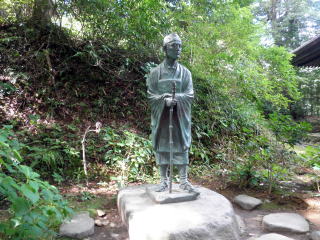
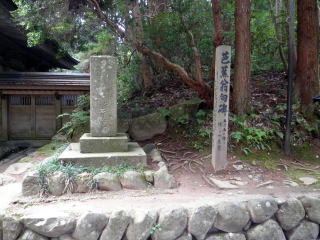
The group of temples in Hiraizumi, Iwate prefecture was designated as
world heritage
on May 2011 together with Ogasawara islands, 1,000 km off Tokyo bay.
The FUJIWARAs constructed many temples in 11th and 12th century to console
the souls of
the dead who had perished in the past wars in Tohoku region.
FUJIWARA Kiyohira established Oshu Fujiwara regime at Hiraizumi in 1087
with its territory
all over Tohoku region, which enjoyed prosperity and independence from
the emperor's
government in Kyoto very much for 100 years with his son, Motohira and
grandson, Hidehira.
So Hiraizumi was the second biggest city after Kyoto. Later, his great-grandson,
Yasuhira
was defeated in 1189 by MINAMOTO no Yoritomo, who established the first
Samurai's
government in Kamakura, 56 km south of Tokyo in 1185.
Hiraizumi city is located about 500 km north of Tokyo. To visit there one
takes a bullet train of
Tohoku Shinkansen at Tokyo station for Ichinoseki taking about 2 hours
and half, then
changes to a local train of Tohoku main line to Hiraizumi and arrives at
Hiraizumi in 10 minutes.
Another boat is nearing from the upstream.
The boat goes up the stream by a boatwoman
with a pole and we see many carps, sweet fishes,
etc. swimming in the water. Even some of them
make a splash from time to time near the boat.
There is abundant greenery on the cliffs of 100
meters high at the both sides.
Many big carps are swimming near the boat
at the landing place.
We arrive at the landing place and walk up
10 minutes along the river and come to this cliff
of 120 meters high.
A boat has started going upstream
with a boatwoman.
A ticket window at left in front of this building
with souvenir shops. And landing place to
pleasure boats is at left.
This artificial stream is called "Mizuyari",
along which noble people used to hold
a party making a linked poem and floating
a very small model boat to carry on a slip
of poem form one to another down
the stream. It was popular during the Heian era
from 9th to 12th century among aristocrats.
Mizuyari only remain here ij Japan.
Statue of MATSUO Basho, who visited here
around 1690 during his trip in Tohoku region.
This is the monument of MATSUO Basho, great poet
whose famous poem is inscribed on it.
It is "Samidare-no Furinokoshite-ya Hikari-do".
It means that Hikari-do remains all alone after May rain
has dropped calmly.
This is a cover building constructed in 1963,
in which Konjiki-do (golden ) temple is placed.
There are many statues of Buddha and
the bodies of the four heads of the FUJIWARAs
are stored under them.
Going up a little bit from Chuson-ji temple
at left we have Fudo-do temple.
The frontal view of Chusonji temple and
a big incense burner.
FUJIWARA Kiyohira constructed Chuson-ji buddhist temple in 1105 and Konjiki-do
temple
( golden temple) covered with gold in 1124 in its precincts.
This is a uphill approach to Chusonji temple,
which is called slope with view of Moon.
The entrance to the precincts of
Chuson-ji Buddhist temple.
1 Chuson-ji temple and other temples
.


